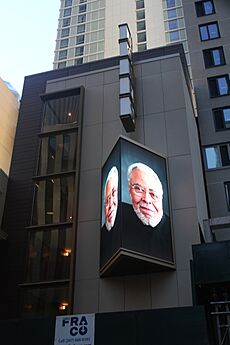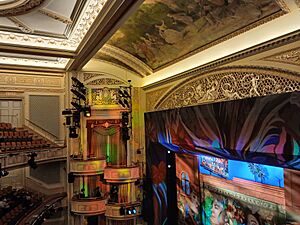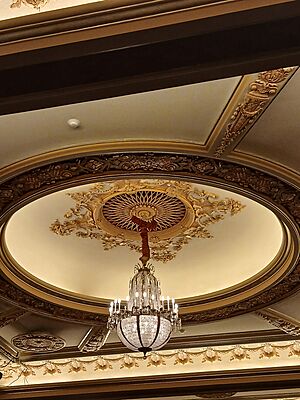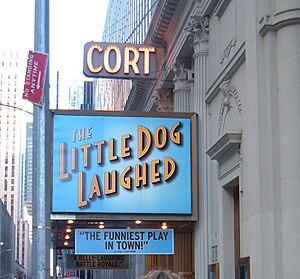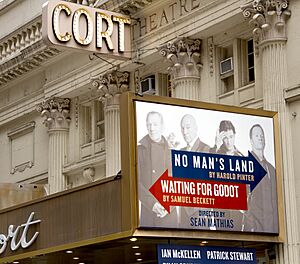James Earl Jones Theatre facts for kids
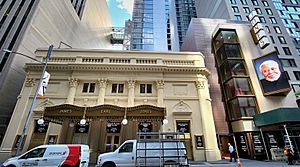 |
|
| Former names | Cort Theatre |
|---|---|
| Address | 138 West 48th Street Manhattan, New York United States |
| Coordinates | 40°45′33″N 73°58′59″W / 40.75917°N 73.98306°W |
| Owner | The Shubert Organization |
| Type | Broadway |
| Capacity | 1,092 |
| Construction | |
| Opened | December 20, 1912 |
| Rebuilt | 2021–2022 |
| Years active | 1912–1969, 1972–present |
| Architect | Thomas W. Lamb |
| Designated | November 17, 1987 |
| Reference no. | 1328 |
| Designated entity | Facade |
| Designated | November 17, 1987 |
| Reference no. | 1329 |
| Designated entity | Lobby and auditorium interior |
The James Earl Jones Theatre, which used to be called the Cort Theatre, is a famous Broadway theater in New York City. You can find it at 138 West 48th Street in the Theater District of Midtown Manhattan. It was built in 1912 for a theater manager named John Cort. The building was designed by architect Thomas W. Lamb.
In 2022, a new wing was added to the theater. The theater has 1,092 seats on three levels and is run by The Shubert Organization. Because of its beautiful and historic design, both the outside and inside of the theater are protected as New York City landmarks.
The theater's design is inspired by old French palaces. The front has a large glass-and-metal sign called a marquee over the doors and tall columns. Inside, the lobby has fancy marble walls and a curved ceiling. The main theater area, called the auditorium, has a large stage, a main floor (the orchestra), and two balconies. One of the coolest features is the arch over the stage, which has special "art glass" that can light up during shows.
The theater was renamed in 2022 to honor the famous actor James Earl Jones. This was a special event because it became only the second Broadway theater to be named after a Black artist.
Design of the Theater
The James Earl Jones Theatre was designed in 1912 by Thomas W. Lamb. He used a style called neoclassical, which was inspired by ancient Greek and Roman buildings. A new, modern wing was added to the west side of the theater between 2021 and 2022.
The Outside of the Theater
The front of the theater is made of marble. The design was modeled after the Petit Trianon, a small palace at Versailles in France. It has four tall, grooved columns with fancy tops.
At street level, there are several sets of glass and aluminum doors. A large sign, called a marquee, hangs over the main entrance. The original marquee had a wavy, artistic design. It was replaced with a simpler one, but in 2021, a new marquee was installed that looks like the original. It has three arches and round lamps hanging from it.
Above the marquee, there are windows and carved decorations. The name "Cort Theatre" is still carved into the stone at the top of the building. A neon sign with the "Cort" name was added in 1937 but was removed during the 2021 renovation.
The New Annex
The new wing, or annex, is a five-story building next to the original theater. It has a modern look, with cream-colored panels and polished brownstone. It also has glass display boxes and a large LED screen on its upper floors. This annex provides more space for lounges, restrooms, and backstage areas.
The Inside of the Theater
The inside of the theater was designed to feel elegant and grand. The main colors are old rose and gold, with decorations in champagne and sienna, a type of reddish-brown.
Lobby
When you enter the theater, you walk into a rectangular lobby. The walls are covered in a special white marble called Pavanozza. The doors leading into the main theater have decorative frames. On one wall, there is a statue of the French queen Marie Antoinette. The lobby has a beautiful curved ceiling with a large bronze and crystal chandelier in the center.
Auditorium
The auditorium is the main area where the audience sits. It has a main floor called the orchestra, two balconies, and special seating areas called boxes. The theater can hold 1,092 people. The seats are divided among the orchestra, two balconies, and boxes along the sides.
The walls are decorated with fancy plasterwork. The balconies have flower designs on their undersides and crystal lights. On each side of the stage, there are two levels of boxes. These boxes have curved railings with lattice patterns.
Other Cool Features
The arch around the stage, called the proscenium arch, is one of the theater's most unique features. It is made of plasterwork with special art glass that can be lit up. This feature was turned off for many years but was restored during the 2021 renovation.
The ceiling above the audience is also very decorative. It is divided into three sections with a large, circular dome in the center. A huge bronze and crystal chandelier hangs from the dome, lighting up the entire room.
History of the Theater
The area around Times Square became the center of New York's theater world in the early 1900s. A theater manager named John Cort, who was very successful on the West Coast, decided to build his own theater in New York.
Opening and Early Years
The Cort Theatre opened on December 20, 1912. The first show was a play called Peg o' My Heart, which was a huge success and ran for over 600 performances. At the time, most theaters were on the other side of Broadway, so some people thought the Cort was in the "wrong" location. But the theater was so beautiful and hosted so many hit shows that it quickly became known as a "lucky" place.
Other hit shows in the early years included Under Cover (1914), The Princess Pat (1915), and The Yellow Jacket (1916). The theater hosted many different kinds of shows, including plays by William Shakespeare and popular comedies.
The Shubert Organization Takes Over
In 1927, The Shubert Organization, a major theater company, bought the Cort Theatre. The theater continued to host many important productions. In 1928, future movie star Katharine Hepburn made her first Broadway appearance here in a play called These Days.
The 1930s and 1940s saw many successful shows, including Room Service (1937), The Male Animal (1940), and A Bell for Adano (1944). During World War II, the theater hosted patriotic and important plays. In 1949, future movie star Grace Kelly made her Broadway debut in The Father.
The 1950s were also a great decade for the theater. It hosted famous plays like Saint Joan (1951) and The Diary of Anne Frank (1955). In 1958, actor James Earl Jones made his Broadway debut in Sunrise at Campobello.
TV Studio and Return to Theater
From 1969 to 1972, the theater was not used for plays. Instead, the television network CBS leased it and turned it into a TV studio for The Merv Griffin Show. After the show moved to California, the theater returned to hosting live plays.
One of the biggest hits of the 1970s was The Magic Show, which opened in 1974 and ran for almost five years. In the 1980s, the theater hosted the powerful South African musical Sarafina!.
In 1987, the theater was officially named a New York City landmark. This means its historic design is protected and cannot be changed too much.
Recent History and Renaming
In the 2000s and 2010s, the Cort Theatre hosted many popular plays and musicals. These included Fences (2010) starring Denzel Washington and Viola Davis, Fish in the Dark (2015) created by Larry David, and Bright Star (2016) by Steve Martin and Edie Brickell.
The theater closed in March 2020 because of the COVID-19 pandemic. During this time, it underwent a major renovation. A new annex was built, and the original theater was restored.
In March 2022, the Shubert Organization announced that the theater would be renamed the James Earl Jones Theatre. This was done to honor the legendary actor and to increase diversity in the theater community. The newly renovated and renamed theater reopened in November 2022. The first show in the new theater was Ohio State Murders starring Audra McDonald.
Famous Shows at the Theater
Here are some of the most famous shows that have played at the James Earl Jones Theatre over the years.
1910s to 1990s
| Opening year | Name |
|---|---|
| 1915 | The Princess Pat |
| 1919 | Abraham Lincoln |
| 1922 | Merton of the Movies |
| 1937 | Room Service |
| 1940 | The Male Animal |
| 1940 | Charley's Aunt |
| 1942 | Cafe Crown |
| 1946 | Lady Windermere's Fan |
| 1951 | Saint Joan |
| 1954 | The Rainmaker |
| 1955 | The Diary of Anne Frank |
| 1958 | Sunrise at Campobello |
| 1960 | Once Upon a Mattress |
| 1961 | Purlie Victorious |
| 1963 | One Flew Over the Cuckoo's Nest |
| 1974 | The Magic Show |
| 1984 | Ma Rainey's Black Bottom |
| 1988 | Sarafina! |
| 1990 | The Grapes of Wrath |
| 1995 | The Heiress |
2000s to Present
| Opening year | Name |
|---|---|
| 2005 | On Golden Pond |
| 2006 | Barefoot in the Park |
| 2008 | The 39 Steps |
| 2009 | You're Welcome America: A Final Night with George W. Bush |
| 2010 | Fences |
| 2011 | Stick Fly |
| 2013 | No Man's Land and Waiting for Godot |
| 2014 | The Cripple of Inishmaan |
| 2015 | Fish in the Dark |
| 2016 | Bright Star |
| 2017 | M. Butterfly |
| 2019 | King Lear |
| 2022 | Ohio State Murders |
| 2023 | Gutenberg! The Musical! |
| 2024 | The Heart of Rock and Roll |
| 2025 | Real Women Have Curves |
See also
- List of New York City Designated Landmarks in Manhattan from 14th to 59th Streets
- List of Broadway theaters




